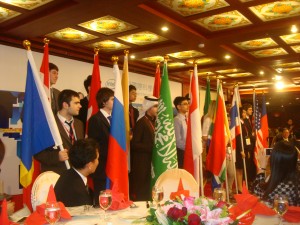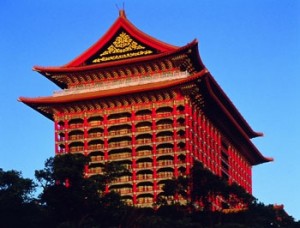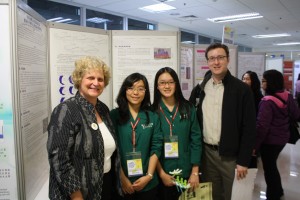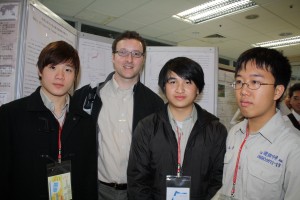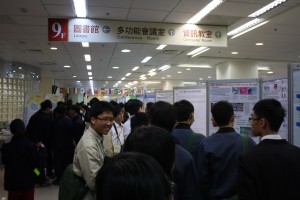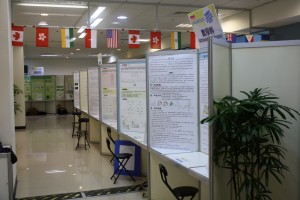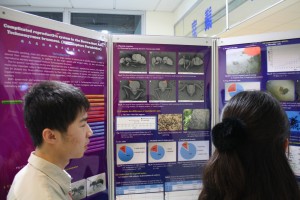New generation, new power — that’s the slogan of the 2012 TISF, or Taiwan International Science Fair. It is a year of change for the TISF, as well as a year of growth. Hundreds of students, from 17 countries have participated in this year’s TISF, including representatives from Intel ISEF (the International Science & Engineering Fair), displaying projects in the following subject areas: mathematical sciences, physics & astronomy, chemistry, earth & planetary sciences, animal sciences, plant sciences, microbiology, biochemistry, medicine & health, engineering, computer science and environmental science.
THL’s Barnas Monteith and Penny Noyce, while visiting Taiwan, had the opportunity to attend several events of the TISF, which is a week long event, held in the Shihlin district of Taipei. Many of you may know Shilin as the Tourist Night Market area, where you can get such famous Taiwan street snacks as “tso doufu” (stinky tofu), oajen (fried oyster omelets), xiangchang (Taiwanese sausage on a stick), not to mention various parts of chickens, ducks and other animals grilled, broiled, fried or otherwise cooked on a stick (which the author of this blog loves by the way). However, Shilin district is also home to various educational science museums such the National Taiwan Space Museum , and the National Taiwan Science Education Center (NTSEC), which is the host organization of TISF.
The week-long international science fair started off with a welcoming event at the Grand Hotel, which is only a short distance away from the NTSEC. The Director General of the NTSEC, Dr. Chu Nyan Shan, welcomed all to the event with inspiring words of encouragement, on behalf of the 56 year old institute, and home to the ever-expanding TISF. Following the welcoming speeches and flag event, was a “Meet the Scientist” lecture and panel discussion featuring: Academician (meaning, a fellow of Academia Sinica, Taiwan’s premier Academic council, similar to the US AAAS) Dr. C. Y. Cyrus Chu (朱敬一院士) , economist and newly appointed head of the Taiwan National Science Council, Academician Dr. “Frank” Hsia-San Shu (徐遐生院士), energy researcher and head of the Taiwan Central Normal University, and Academician Dr. Chao Han Liu (劉兆漢院士), a climate scientist and one of the key innovators behind Taiwan’s Formosat weather satellite array, and its 12 satellite array successor, COSMIC, partly funded by the US/NOAA. Ambassadors and other delegates from various countries were in attendance, not to mention honored guests Penny Noyce of the Noyce Foundation and Barnas Monteith of the MA State Science & Engineering Fair.
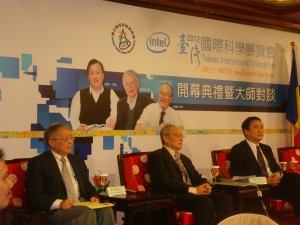
Left to Right: Dr. Chao Han Liu (劉兆漢院士), Dr. “Frank” Hsia-San Shu (徐遐生院士), and Dr. C. Y. Cyrus Chu (朱敬一院士)
Students at TISF face a rigorous week of educational workshops, lectures at local universities, cultural events, not to mention multiple rounds of judging, followed by press events and public viewing days, prior to the final grand award ceremony, in which the top award (a full scholarship to anywhere in the world) is presented by Taiwan President Ma Ying Jiu. THL’s Penny Noyce and Barnas Monteith attended one of the public viewing days and had a chance to meet with a few inspiring students and see their projects.
Observing Sudden Stratosphere Warming by Using data from Formosat III, a team project by several students at an all-girls school in central Taiwan, looks at data from one of Taiwan NSPO’s (the equivalent of NASA in the US) active high resolution weather satellites. The data was used to demonstrate that there are substantially more dramatic seasonal warming trends observed in the upper atmosphere, as altitude increases.
Employing GPS to Observe Tsunami-Ionospheric Disturbances, another team project by students from an all boys school in central Taiwan, takes a look at NOAA oceanic data trends to determine subtle weather patterns surrounding Tsunami events, in order to attempt to create a predictive model.
Seeing With Your Tongue, is a part-biology, part-engineering project by an enthusiastic international student from Romania, who provided a lengthy explanation of a novel method to aid the blind in seeing, through the use of a camera which can recognize written characters such a street signs and convert them to tactile (touch) signals on the tongue. Because the human tongue contains a large number of nerves (more than most other areas of the body), it is an ideal location to provide high resolution “touch response” information to a person, and a small tongue sensor device is a portable way to be able to see on the go, in a pinch. The device also operates like a visual aid, warning the user of any impending danger or nearby objects, through vibrations.
The projects at TISF were mind blowing, some clearly worth of patents, and certainly all would be competitive at the Intel International Science & Engineering Fair, perhaps even a select few may someday lead to Nobel prizes in the not-too-distant future.
TISF has been a recognized and highlighted success for Intel Taiwan, as well – the fair’s primary corporate sponsor, with TISF winners placing extremely well at ISEF, and spreading the adoption of inquiry learning into classrooms across Taiwan. As mentioned above, it is also a year of change for TISF. At the helm of the fair is new Executive Director Christina Huang, taking over for Marianna Fung, who was instrumental in consolidating a national science fair for the country of Taiwan, and then expanding it into a grand multi-nation event at Taiwan’s premier science education center. Christina is also accompanied by various new staff who will assist in leading TISF moving forward, as well as a commitment from Intel to fund TISF well into the future.
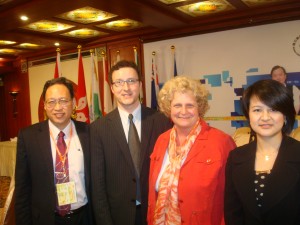
Left to right: Dr. Chu Nyan Shan, Director-General of NTSEC, MSSEF's Barnas Monteith, Noyce Foundation's Penny Noyce, and Rachel Liu, Head of Intel Education, Taiwan
While TISF is an amazing success story, evolving from a central science fair for a handful of regional fairs throughout the country to a globally recognized event in a span of not much more than a decade, it also faces challenges. The issues facing the TISF, and science fairs throughout Taiwan are many, and not dissimilar to ones faced in the US and even in states with considerable academic talent and scientific/engineering resources such as Massachusetts. Funding for science fair / inquiry related materials and learning time in public schools and private schools alike, throughout the country, is relatively meager. Schools are faced with increased focus on tested curriculum, and accountability of teachers. Not to mention, while schools in Taiwan spend considerably more time on science & engineering than US schools, they also face a shortage of resources (related both to learning time and physical facilities), and often parents with means supplement their child’s education with after-school “bushiban” courses, and standardized testing prep “cram” courses. Resource inequality continues to be a problem, where cities and private schools have access to considerably more resources than the public schools in remote or “high needs” regions. Sometimes, students and teachers are left discouraged, feeling like sometimes the science fair, can actually be a “science unfair”. These are the very problems that face the MA State Science & Engineering Fair, which is now a 63 year old organization, as well as regional and state fairs across America. However, take it from a kid who grew up in a lower middle class suburb who won ISEF and other major fairs – a few times… hands on learning is not just for the rich, and as the cliché goes, where there’s a will there’s a way. Competitive science fair projects can indeed be done on a shoestring budget – and so can inquiry hands-on learning. I discuss ways to get really expensive science experiments done for almost no money, in my upcoming book about science fairs: Dinosaur Eggs & Blue Ribbons. Like our other initial release books, DE&BR will be translated into complex/traditional Mandarin and offered in English in the US and in English & Mandarin in Taiwan (as well as other languages in other countries, in the future). Getting to my next point…one more very big problem facing TISF students from Taiwan as well as other international students in general is language barrier: students in Taiwan and other developed countries are faced with a deluge of increased assessments over time, and most of them require more and more scientific/technical English. In the US, while we do have secondary language requirements in most schools, we do not require students to conduct significant amounts of testing in other languages (or at least not as it relates to anything but a test of the language itself). It would be difficult for me to imagine having conducted my science fair judging sessions in Mandarin Chinese when I was just 14 years old, so I can only imagine how difficult it must be for others to not only learn conversational English, but to learn technical vocabulary at such a young age. It goes well above and beyond just learning a subject matter, and devising a novel experiment or designing a new engineering concept – it is learning a whole other culture, and I have great respect for students who are able to do this effectively. The students we saw at TISF are truly talented and amazing individuals (and teams)!
One of our primary goals in founding Tumblehome Learning was to offer parents and teachers supplemental out-of-school learning materials at a low cost, that are actually fun — not just the boring day to day classroom lessons that tend not to inspire children to want to become scientists, engineers or educators in these fields. Whether kids choose to become scientists or not, THL’s learning materials are an easy investment for most parents/teachers to offer young ones a look into a different world, and to provide an opportunity for critical thinking and inquiry learning that might not otherwise exist in the formal learning environment. Our goal is not only to encourage the next MSSEF/Intel winners and TISF winners, but to inspire a life of constant exploration and learning.

